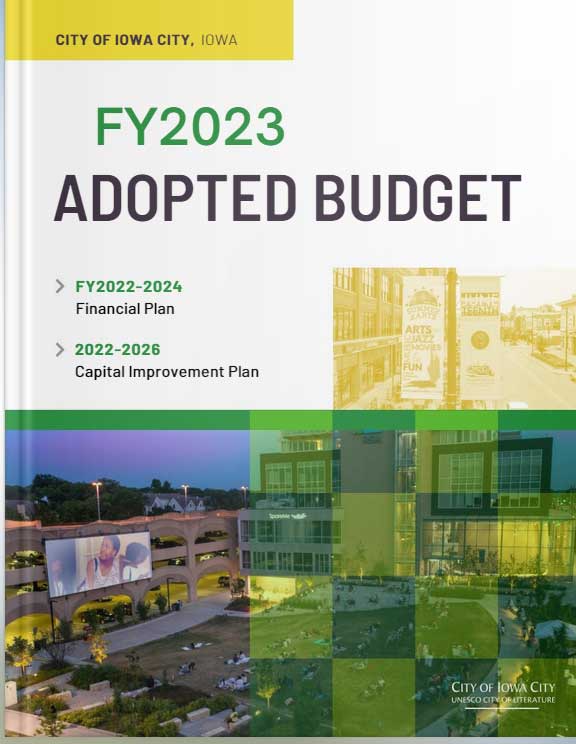The City of Iowa City faces several infrastructure challenges, including maintaining and upgrading its aging wastewater treatment plant and expanding its transit system to meet growing demand. The city’s roadways and bridges also require regular maintenance and improvements to handle increasing traffic volume. Additionally, Iowa City is vulnerable to flooding due to its location in a floodplain, and the city is working to improve its stormwater management systems and infrastructure to mitigate the impacts of flooding.

Sample Highlights from the Capital Improvement Plan
Project ID
Project Title
Project Start Year
Project Description
Project Spend Total
Page Ref
Project Satus
583530
Runway 7 Environmental Assessment
2025
“Follow up project from Runway 7/25 Conversion. This is the Environmental Assessment required before constructing an approximately 213 feet extension at the
Runway 7 end of Runway 7/25.”
150000
538
Not Started
583540
Runway 7/25 Pavement Repairs
2024
Runway 7/25 joint sealant and miscellaneous pavement repairs.
250000
541
Not Started
583546
Fire Apparatus Replacement Program
2024
“Replacement of Fire Department equipment:
2024 Fire Pumper/Aerial #358
2024 Scotty House
2026 Fire Pumper #352
2027 Fire Pumpers #353 & #354”
2560000
543
Not Started
583559
Hwy 6 Sidepath – Broadway to Fairmeadows
2025
“Construction of sidepath extension along Hwy 6 between Broadway Street and Fairmeadows Blvd and along First Avenue from the south side of Hwy 6 to Lower
Muscatine Road.”
1700000
548
Not Started
583586
Upper City Park Improvements
2024
“In 2023, a Upper City Park master plan will be developed. In 2024, Upper City Park improvements will be constructed which may include demolition of four picnic
shelters and one restroom in Upper City Park and replacement with one large and two small shelters and restroom facility.”
600000
559
Not Started
Explore all options available to you!
Citylitics offers access to over 30,000 unique locations across North America through our Capital Projects Dashboard (CPD).
Capital Projects Dashboard (CPD) provides a comprehensive market view of all planned infrastructure spend in one single view with powerful filters such as: population, project value, fiscal year, project status, project description, geography, and more. The dashboard will help identify opportunity hot spots, create data-driven forecasts you can be confident in with bottom-up data for the next 5 years of planned infrastructure spend, and uncover true market needs.
How to Read a Capital Improvement Plan (CIP) for Business Development?
When a city, municipality or state issues a Capital Improvement Plan (CIP), it can be overwhelming and daunting, but there are a few key things you need to investigate. Let’s start with the definition of CIP – A Capital Improvement Plan (CIP) contains all the individual capital projects, equipment purchases, and major studies for a local government; in conjunction with construction and completion schedules, and in consort with financing plans. The plan provides a working blueprint for sustaining and improving the community’s infrastructures. It coordinates strategic planning, financial capacity, and physical development. A CIP stands at the epicenter of a government’s Planning, Public Works, and Finance departments. When a CIP is issued, it typically includes the following information:
- A listing of the capital projects or equipment to be purchased
- The projects ranked in order of preference
- The plan for financing the projects
- A timetable for the construction or completion of the project
- Justification for the project
- Explanation of expenses for the project
Now, for business development, while the capital plan is interesting, the capital program is for capital expenditures that extends five to ten years beyond the capital budget. Knowing the difference is important so you can influence upcoming program versus just responding to an RFP. If reading the CIP makes your head explode, or you want to save time, Request a Demo of Citylitics CIP dashboard with over 20,000 CIPs from USA and Canada. Citylitics has 20,000 plus available CIPs, how can we help you? What states, cities or counties are you looking to improvement your business development, we can assist you in influencing an upcoming RFP versus simply responding to an RFP. Citylitics Capital Projects Dataset is a comprehensive resource for businesses and organizations looking to track and analyze planned infrastructure spend in their area. The dataset offers a range of features and benefits, including:
- Comprehensive Market View: The dataset provides a single view of all planned infrastructure spend, with powerful filters such as population, project value, fiscal year, project status, project description, geography, and more. This allows businesses to gain a comprehensive understanding of the market and identify new opportunities.
- Identify Opportunity Hot Spots: The dataset offers map views and filters that allow users to identify opportunity hot spots where they need to allocate resources. This helps businesses to understand where they should focus their efforts to achieve the best results.
- Create Data-Driven Forecasts: The dataset provides bottom-up data for the next 5 years of planned infrastructure spend, allowing businesses to create data-driven forecasts they can be confident in.
- Uncover True Market Needs: The dataset allows businesses to develop long-term business plans, R&D, and growth initiatives based on true, bottom-up market needs instead of opinions and anecdotes. This helps businesses to make more informed decisions and achieve better results.
With Citylitics Capital Projects Dataset, businesses can gain a deeper understanding of planned infrastructure spend in their area, which can help them to identify new opportunities and make more informed decisions.
